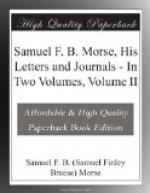Richly as he deserved that his sun should set in an unclouded sky, this was not to be. Sorrows of a most intimate nature crowded upon him. He was also made the victim of a conscienceless swindler who fleeced him of many thousand dollars, and, to crown all, his old and indefatigable enemy, F.O.J. Smith, administered a cowardly thrust in the back when his weakening powers prevented him from defending himself with his oldtime vigor. From a very long letter written by Smith on December 11, 1871, to Henry J. Rogers in Washington, I shall quote only the first sentences:—
Dear Sir,—In my absence your letter of the 11th ult. was received here, with the printed circular of the National Monumental Society, in reply to which I feel constrained to say if that highly laudable association resolves “to erect at the national capital of the United States a memorial monument” to symbolize in statuary of colossal proportions the “history of the electromagnetic telegraph,” before that history has been authentically written, it is my conviction: that the statue most worthy to stand upon the pedestal of such monument would be that of the man of true science, who explored the laws of nature ahead of all other men, and was “the first to wrest electron-magnetism from Nature’s embrace and make it a missionary to, the cause of human progress,” and that man is Professor Joseph Henry, of the Smithsonian Institution.
Professor Morse and his early coadjutors would more appropriately occupy, in groups of high relief, the sides of that pedestal, symbolizing, by their established merits and cooperative works, the grandeur of the researches and resulting discoveries of their leader and chief, who was the first to announce and to demonstrate to a despairing world, by actual mechanical agencies, the practicability of; an electro-magnetic telegraph through any distances.
Much more of the same flatulent bombast follows which it will not be necessary to introduce here. While Morse himself naturally felt some delicacy in noticing such an attack as this, he found a willing, and efficient champion in his old friend (and the friend of Henry as well) Professor Leonard D. Gale, who writes to him on January 22, 1872:—
“I have lately seen a mean, unfair, and villainous letter of F.O.J. Smith, addressed to H.J. Rogers (officer of the Morse Monumental Association), alleging that the place on the monument designed to be occupied by the statue of Morse, should be awarded to Henry; that Morse was not a scientific man, etc., etc. It was written in his own peculiar style. The allegations were so outrageous that I felt it my duty to reply to it without delay. As Smith’s letter was to Rogers, as an officer of the Association, I sent my reply to the same person. I enclose a copy herewith.
“Mrs. Gale suggests an additional figure to the group on the monument—a serpent with the face of F.O.J.S., biting the heel of Morse, but with the fangs extracted.”




